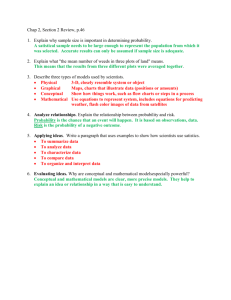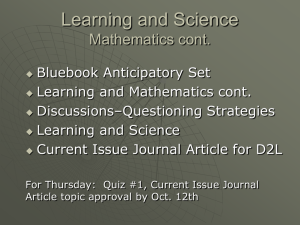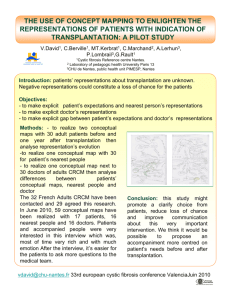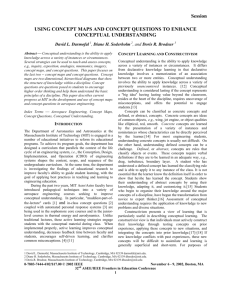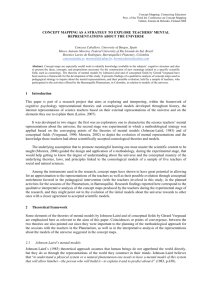Algebra syllabus
advertisement
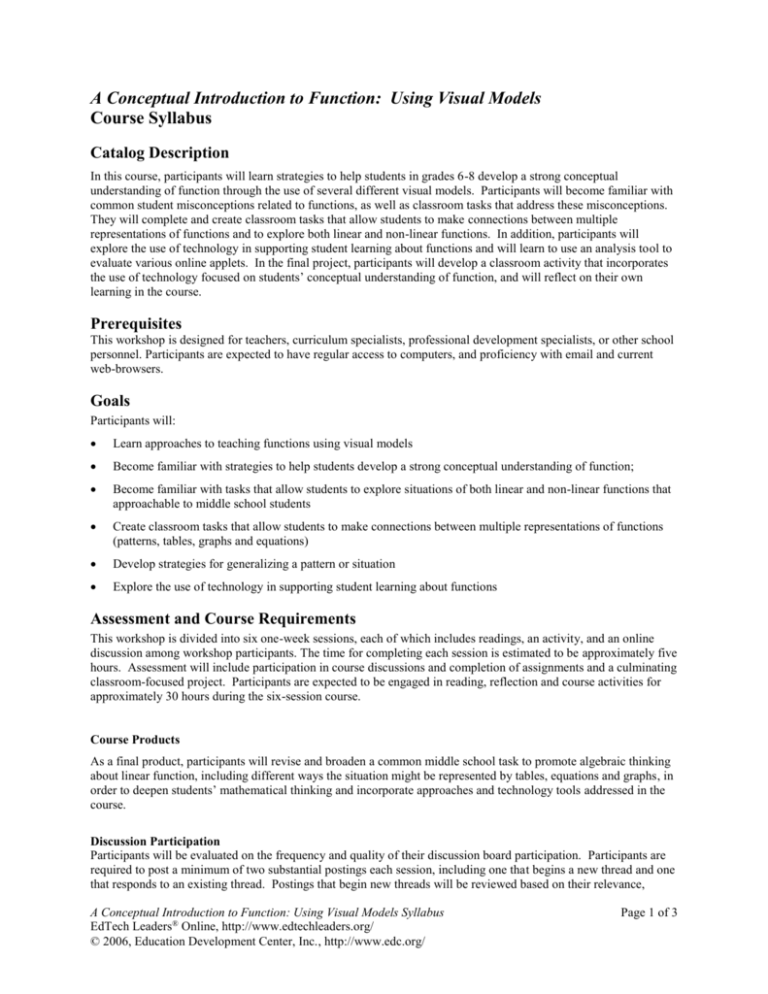
A Conceptual Introduction to Function: Using Visual Models Course Syllabus Catalog Description In this course, participants will learn strategies to help students in grades 6-8 develop a strong conceptual understanding of function through the use of several different visual models. Participants will become familiar with common student misconceptions related to functions, as well as classroom tasks that address these misconceptions. They will complete and create classroom tasks that allow students to make connections between multiple representations of functions and to explore both linear and non-linear functions. In addition, participants will explore the use of technology in supporting student learning about functions and will learn to use an analysis tool to evaluate various online applets. In the final project, participants will develop a classroom activity that incorporates the use of technology focused on students’ conceptual understanding of function, and will reflect on their own learning in the course. Prerequisites This workshop is designed for teachers, curriculum specialists, professional development specialists, or other school personnel. Participants are expected to have regular access to computers, and proficiency with email and current web-browsers. Goals Participants will: Learn approaches to teaching functions using visual models Become familiar with strategies to help students develop a strong conceptual understanding of function; Become familiar with tasks that allow students to explore situations of both linear and non-linear functions that approachable to middle school students Create classroom tasks that allow students to make connections between multiple representations of functions (patterns, tables, graphs and equations) Develop strategies for generalizing a pattern or situation Explore the use of technology in supporting student learning about functions Assessment and Course Requirements This workshop is divided into six one-week sessions, each of which includes readings, an activity, and an online discussion among workshop participants. The time for completing each session is estimated to be approximately five hours. Assessment will include participation in course discussions and completion of assignments and a culminating classroom-focused project. Participants are expected to be engaged in reading, reflection and course activities for approximately 30 hours during the six-session course. Course Products As a final product, participants will revise and broaden a common middle school task to promote algebraic thinking about linear function, including different ways the situation might be represented by tables, equations and graphs, in order to deepen students’ mathematical thinking and incorporate approaches and technology tools addressed in the course. Discussion Participation Participants will be evaluated on the frequency and quality of their discussion board participation. Participants are required to post a minimum of two substantial postings each session, including one that begins a new thread and one that responds to an existing thread. Postings that begin new threads will be reviewed based on their relevance, A Conceptual Introduction to Function: Using Visual Models Syllabus EdTech Leaders® Online, http://www.edtechleaders.org/ © 2006, Education Development Center, Inc., http://www.edc.org/ Page 1 of 3 demonstrated understanding of course concepts, examples cited, and overall quality. Postings that respond to other participants will be evaluated on relevance, degree to which they extend the discussion, and tone. Session Overviews: Session One: Developing a Conceptual Understanding of Function The first session in this course introduces some approaches to the study of functions. The approaches are based on building a conceptual understanding of function prior to any work with formal algebraic representation. Participants will examine various examples of related sets of numbers resulting from real-life situations that are familiar to students. These include scenarios such as a ball bouncing, the pricing of items in a store, the temperature in a particular location during the course of a day, and the population throughout the day at a movie theater. Participants will also explore the concept of a function machine, examining inputs and outputs and the relationship between these two elements of a function machine. They will explore language such as “is a function of…” and “depends upon” in order to move toward a formal definition of function in which each input yields one output. Throughout the session, participants explore function in much the same way they would explore it with their students. Session Two: Developing a Graphic Image of Function In this session, participants will focus on qualitative graphs that represent situations of movement over time. They will consider how connecting the context of a situation with the picture of its graph may help students to develop both their graphing skills and their conceptual understanding of function. Participants complete several activities that focus on relating simple motions to their graphical representations, emphasizing the shape of the graph and what the shape conveys about the motion. Participants will consider common misconceptions about interpreting graphs and will use various technology tools to explore ways to address these misconceptions. Participants will also be introduced to a framework for evaluating a technology tool or activity for particular learning goals. Session Three: Relating Rules to Visual Models Participants now turn their attention to various situations that result in linear patterns, such as relating the number of chairs around tables of different lengths or the number of trips it takes to get several children and adults across a river. Participants work through a variety of problems in which they develop a visual model to represent the situation and come up with a general description of a rule that describes the relationship. They then consider variations of the pattern and describe in words how the corresponding rule would change. The emphasis here is on examining the nature of the relationship, and predicting how the rule will change as the relationship changes. Questions such as “What changes?,” “What stays the same?” and “How does the rule relate to the model?” will lead throughout the session, and will provide a foundation for further work with more formal algebraic representations in the next session. Participants will discuss and identify criteria for shaping mathematical tasks to encourage higher level thinking among students. Session Four: Using a Table and Equation to Represent a Linear Function In this session, participants will build on pattern work from the previous session as they relate tables and equations to verbal descriptions and models. Participants will revisit the use of input-output machines to generate a table of values and will explore strategies for helping students move from the recursive pattern in a table of values to the functional rule. Participants will learn particular strategies for generating equations of linear patterns, such as using a third column to identify and generalize change. They will also study examples of student work to gain greater insight into students’ ways of thinking. Session Five: Not All Functions are Linear This session focuses on non-linear function in order for participants to consider a more broad definition of function. During this session, participants will work with a variety of nonlinear functions such as exponential functions, quadratic functions and step functions. These examples of function will be drawn from situations familiar to middle school students such as repeated doubling of a number, patterns in square numbers and hourly rental or pay rates. Participants will connect previous work with visual representations in order to compare and contrast linear and nonA Conceptual Introduction to Function: Using Visual Models Syllabus EdTech Leaders® Online, http://www.edtechleaders.org/ © 2006, Education Development Center, Inc., http://www.edc.org/ Page 2 of 3 linear functions. Participants will evaluate technology tools for exploring nonlinear function. The session will culminate with students establishing a definition of function derived from their experiences throughout the course. Session Six: Final Project Participants are given a middle school task that is to be used as the basis for the final project. They will consider how to revise and broaden the task to promote algebraic thinking about linear function, including different ways the situation might be represented by tables, equations and graphs. Participants will consider how to use technology to support the task and will be expected to identify a technology tool they would use in advance or in conjunction with the task. Participants will also write a personal reflection on their learning in the course and their rationale for their task design. A Conceptual Introduction to Function: Using Visual Models Syllabus EdTech Leaders® Online, http://www.edtechleaders.org/ © 2006, Education Development Center, Inc., http://www.edc.org/ Page 3 of 3

